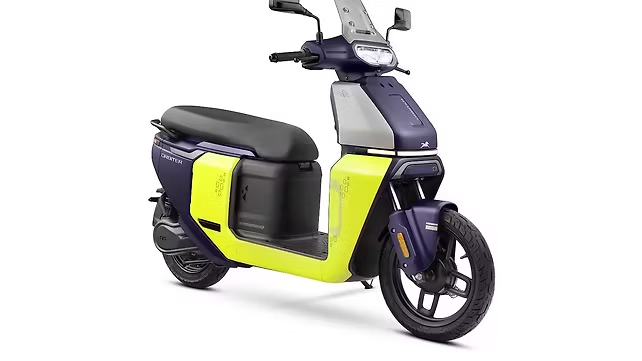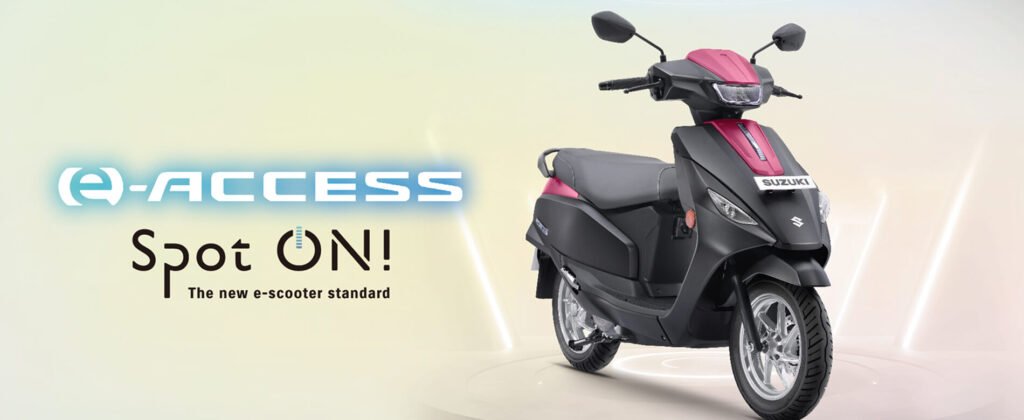In the bustling electric two-wheeler arena of India, where giants like Ola and Ather dominate the headlines, TVS Motor Company is quietly plotting its next move. Enter the TVS Orbiter— the brand’s latest electric scooter, launched on August 28, 2025, and priced at a wallet-friendly ₹99,900 (ex-showroom, Bengaluru, inclusive of PM e-Drive subsidy).
Slotted just below the popular iQube lineup, this entry-level EV aims to make green commuting accessible without skimping on practicality. With a claimed 158km IDC range, segment-first features like cruise control, and a cavernous 34L boot, the Orbiter isn’t just another scooter—it’s TVS’s bid to capture the everyday urban rider. Our full review drops tomorrow, but for now, let’s unpack the specs, design, and what makes this 1-lakh wonder tick.
Gone are the curvaceous lines of the iQube; the Orbiter embraces a minimalist, boxy aesthetic that’s equal parts utilitarian and futuristic. Picture a flat, extended seat (845mm length for easy pillion comfort), a spacious 290mm flat floorboard, and a single large side panel that sweeps from front apron to tail like a seamless canvas.
Up front, a handlebar-mounted LED headlamp pairs with a striking LED DRL strip reminiscent of the TVS Jupiter—subtle nods to TVS’s ICE heritage, but electrified.What sets it apart? That pioneering 14-inch front wheel (paired with a 12-inch rear), a combo unseen in most EVs until now.
It promises better stability and a distinctive stance, though it might nudge up rolling resistance slightly. Ground clearance sits at a healthy 169mm, ideal for India’s patchy roads. And for riders like me (average build, 5’10”), the straight seat feels welcoming—no awkward slants here. Styling thoughts? It’s refreshingly straightforward, ditching flash for function. Flashier? Opt for Neon Sunburst. Subdued? Lunar Grey fits the bill. All six dual-tone shades—Neon Sunburst, Stratos Blue, Lunar Grey, Martian Copper, Cosmic Titanium, and Stellar Silver—are priced identically, no upcharges for vibe.
Powertrain and Performance: Hub-Mounted Heart with Everyday Punch
Under the skin, the Orbiter packs a 3.1kWh lithium-ion battery feeding a rear hub-mounted BLDC motor. It’s not the iQube’s powerhouse (which boasts up to 4.3kW nominal power), but this setup delivers a respectable 2.1kW motor with a top speed of 68km/h and 0-40km/h in around 5 seconds (estimated).
Claimed range? A segment-leading 158km on IDC testing—outpacing the iQube’s base 2.2kWh variant (94km) and even edging the 3.5kWh iQube (145km).
Real-world? Expect 100-120km in mixed city use, depending on your throttle hand.Suspension draws from the iQube’s playbook: Telescopic forks up front and twin gas-charged shocks at the rear, but with softer damping for comfort over speed.
Braking is straightforward—drum units at both ends with combined braking system (CBS) for confident stops. No disc here, keeping costs down. Charging? A portable 500W unit takes 4-5 hours for 0-80% at home; fast-charging details are TBA, but TVS’s ecosystem promises public station compatibility.
Curious how cruise control and hill hold play out on Bengaluru’s inclines? Or if that 14-inch wheel smooths potholes better than the iQube’s 12-inch setup? Tomorrow’s review will spill the beans.
Features: Smart Enough for the City, Simple for the Wallet
No TFT glamour like the iQube’s 7-inch touchscreen—the Orbiter opts for a color LCD cluster that’s crisp and connected.
Pair it with the TVS SmartXonnect app via Bluetooth for geo-fencing, call/SMS alerts, turn-by-turn nav, theft notifications, and service reminders. OTA updates keep things fresh, while a USB port ensures your phone stays juiced
Nifty extras elevate it: Cruise control for steady highway jaunts (rare in this price bracket), hill hold to tame slopes, and reverse mode for tight parking. It’s one variant only— no dizzying options—making decisions easy. And that boot? 34L of space swallows two half-face helmets (or groceries aplenty), beating the iQube’s 30-32L.
Peek inside: Flat, accessible, and bigger than rivals like the Ather Rizta.Orbiter vs iQube: Quick Spec ShowdownTo see where it slots, here’s a head-to-head with the iQube’s base and mid variants. The Orbiter shines on value and range, but trades premium touches for affordability.
| Feature | TVS Orbiter (Standard) | TVS iQube (2.2kWh Base) | TVS iQube (3.5kWh) |
|---|---|---|---|
| Price (ex-showroom, Bengaluru) | ₹99,900 | ₹94,000 (intro) | ₹1.44 lakh |
| Battery | 3.1kWh | 2.2kWh | 3.5kWh |
| Claimed Range (IDC) | 158km | 94km | 145km |
| Top Speed | 68km/h | 75km/h | 78km/h |
| Motor Power | 2.1kW (hub-mounted) | 2.2kW (hub) | 4.3kW nominal |
| Wheels | 14″ front, 12″ rear | 12″ both | 12″ both |
| Underseat Storage | 34L | 30L | 32L |
| Display | Color LCD | TFT touchscreen | 7″ TFT |
| Key Features | Cruise, hill hold, reverse, app connectivity | Eco/Power modes, nav | Voice assist, ride modes |
| Charging (0-80%) | ~4-5 hours | ~3 hours | ~4.5 hours |
The Orbiter undercuts the iQube on price while matching (or beating) range in its class—perfect for 50-80km daily runs. But if you crave the iQube’s zippy Power mode or larger screen, step up.



